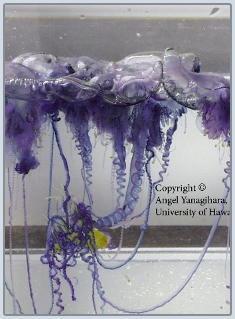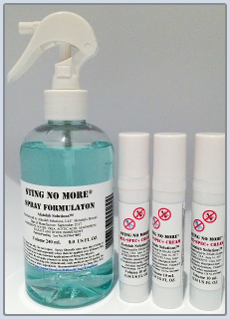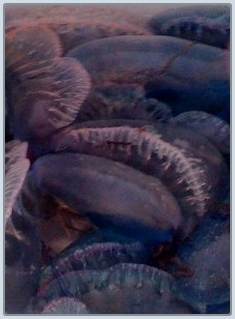Frequently Asked Questions
What should you do if you are stung by a jelly?
Look immediately around in the water to try to see the size, shape and color of the jelly that caused the sting. Seek information from local lifeguards or other professionals as to the type of jelly. Use a vinegar spray if possible or sea water to wash off tentacles if they are still adhering to the skin. If there is a suspicion of box jellyfish and if the victim experiences extreme burning pain, difficulty breathing, dry mouth and extreme anxiety, call 911. Here is a summary of recommendations (https://www.academia.edu/12014049/What_To_Know_About_Box_Jellie)
Are there home remedies you can use?
Hot water saturated with Epsom salts to soak the affected area can be used to heat inactivate the venom, as well partially remove injected venom from the sting site. Vinegar is not a “treatment” and will not inactivate venom that has been injected deep into the skin, but it rapidly inactivates undischarged stinging cells in the tentacles. Urine is likely a “do no harm” remedy that provides low pH but can lead to infection if the site is scratched.
Would you recommend calamine or lidocaine to ease itching and discomfort? Could you take an OTC pain reliever? Like ibuprofen or acetaminophen?
Calamine and lidocaine are virtually ineffective in actually inactivating the venom per se. They can be useful for post sting pain but these and other topical anesthetics do nothing to reduce the impact of the venom. Antihistamines and steroidal anti-inflammatories do work directly addressing the mechanism of action of the venom.
Must you see a doctor?
If there is a suspicion of box jellyfish and if the victim experiences extreme burning pain, difficulty breathing, abdominal cramping, dry mouth and extreme anxiety or cardiac symptoms.
What should you definitely not use to treat it?
Do not use alcohol, ammonia or fresh cold water. Do not apply dermaplast or other agents which contain alcohol or menthol. Do not scrape or rub the sting site. Do not use ice packs as they do nothing to inactivate the venom and only cause a temporary delay in symptoms.
Where are people most likely to be stung (which waters, which coasts in the US?)
There are jellies in all U.S. waters. There are increasing number of reports of box jellies in the Caribbean and Florida but they can be found over much of the southeastern seaboard. Box jellies washed up along the New Jersey shore last fall.
Are jelly stings ever fatal? Are they debilitating?
Box jellyfish stings can be fatal and deaths can be misattributed to drowning. It is critical to understand that jellyfish stings are not like bee stings and do not involve true “allergy” involving IgE with hypotensive shock. Unlike bee stings, box jelly stings lead to a spike in epinephrine with increase in blood pressure. For this reason the overzealous administration of epinephrine could lead to life-threatening elevation in blood pressure and organ failure or hemorrhage. Box jellyfish stings can also lead to months-long skin-site redness and itching. This can be treated with soaks in hot water saturated with Epsom salts, as well as topical steroids and antihistamines.
What are the symptoms of a box jellyfish sting and how are they different from, say, a Portuguese man-o'-war sting?
Both box jellyfish and man-o-war lead to immediate burning pain and can result in itchy welts or scars. The box jelly sting can also result in serious systemic responses. The venom contains pore-forming toxins that are structurally similar to anthrolysin O, the pore-forming toxin produced by anthrax. The box jelly sting is not like a bee sting. The amount of cellular rupture is over ten thousand times that of a bee sting. The venom acts more like a snake venom and causes cellular destruction. Specifically, red blood cells, platelets and white blood cells are lysed. This causes a very high rise in plasma catecholamines, histamine and cytokines. Altogether this presents a complicated clinical outcome that looks more like bacterial shock. The immediate reaction is not at all an IgE “allergy” or “allergic reaction”. Again, since box jelly venom contains these pore-forming proteins that act very quickly to break open blood cells and is not IgE-based allergy; use of an “epipen” is not appropriate.
What is the best treatment for a box sting (and would this be the same treatment for a man-o'-war)? I've read various things in various places. Some say use hot water, others say never use hot water. I'm sure you're familiar with the common home treatments: meet tenderizer, hot water, cold water, vinegar, urine? Do any of those things definitely work or definitely not work?
Double-blind controlled studies and retrospective studies have shown that hot water immersion is most effective. Laboratory work demonstrates that the venom porin is irreversibly inhibited by heat. Flooding the site with vinegar or Epsom salt saturated water can remove tentacles and nondischarged cnidae from the sting site. Magnesium sulfate (~Epsom salt) IV or bolus had been shown to reduce pain and the potentially life- threatening hypertension. Urine is likely a “do no harm” approach as it is mildly acidic and warm and would remove the undischarged cnidae. Cold fresh water is not helpful and can cause more stinging cells to discharge. Ice packs are perhaps the worst approach, as the pressure will increase the discharge and only temporarily slow the venom action. Once the tissue warms again the venom will continue to act and the sting victim may now be out of sight of the care giver. Alcohol or dermaplast should never be used.
What are some tips to avoid getting stung by a box jelly? Would that be the same for a man-o-war?
The best tip for either stinger is to stay out of the water if there are jellies on the beach. The next best tip to avoid box jellies is to avoid leeward Oahu beaches the mornings and evenings of the 8-10th days after each full moon. Additionally, wearing lycra long sleeve rash guard can protect the arms or a full-body exposure suit will protect the body from either stinger.
Are box jellyfish and man-o'-war the only two stinging jellyfish that swimmers in Hawaii's waters need to be concerned about?
These are the main stingers. There are other smaller species of box jellies that do not correlate with the lunar cycle but these are mainly in the marine harbors or far off shore.
Any idea how commonly people get stung by box jellyfish each month or year in Hawaii?
Up to 1,000 ambulance calls have been attributed to box jellies in a single month (July 1997, Honolulu Advertiser). It is hard to estimate the number of total stings but based on our data with an average number of box jellies of 500/month in a 400-meter-long section of Waikiki that could indicate about 10,000 box jellies per month or 120,000 per year. Given the numbers of swimmers, it would seem that 5,000-10,000 stings a year might occur.




![]()




![]()